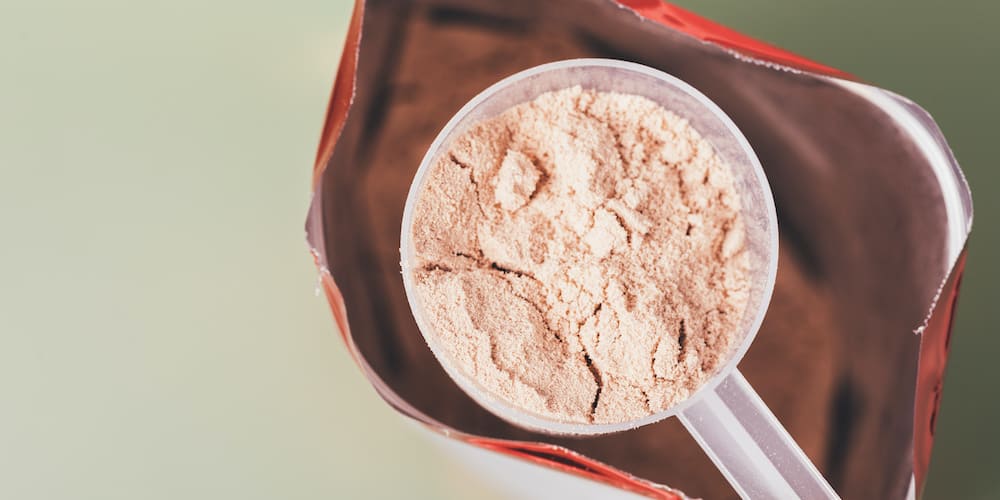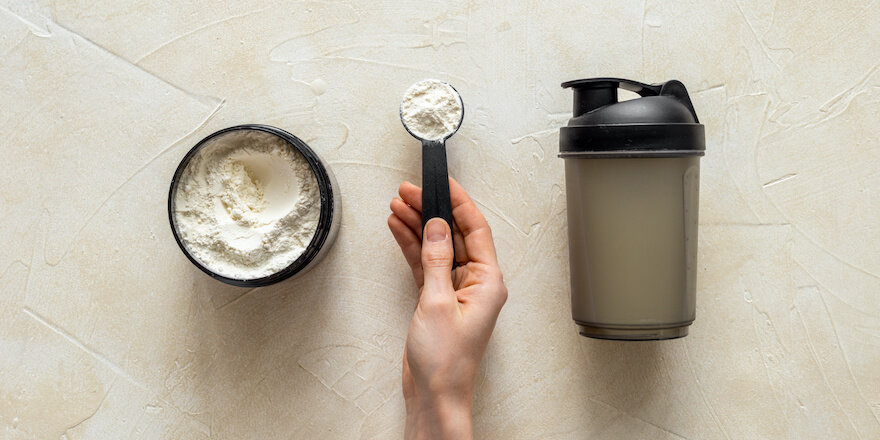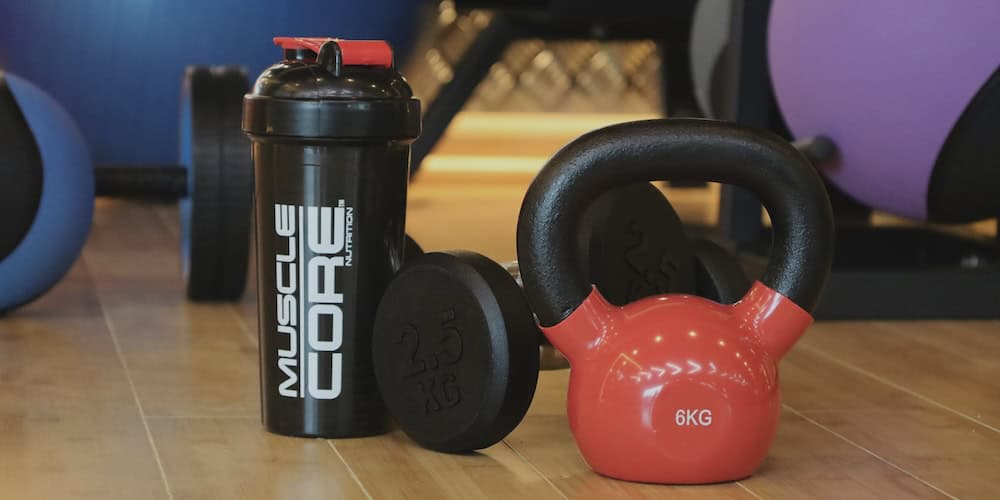The protein shaker, long reserved for bodybuilders, offers many advantages: it is easy to prepare, to transport, and packed with nutrients.
To succeed in your muscle gain journey, you can also customize the composition of your shaker according to your tastes and needs.
With water or milk, plant-based or animal proteins, simply in powder form or with nourishing foods… You have several options!
Here I explain how to optimally prepare your muscle gain shaker, with recipe ideas and tips.
📚 Read also | The 4 best whey isolates for gaining mass, according to a dietitian
My muscle gain shaker recipes
Ingredients to enrich your shaker
Follow the usage instructions provided. Generally, you have 1 measuring scoop to measure the correct amount to pour into the shaker.
You can mix your chosen protein with water or plant milk, adjust the quantity according to desired flavor and texture. On average, count 150 calories per shaker (excluding gainer).
To create a shaker effective for muscle gain, you can, depending on the intensity of your training and appetite, add foods to it.
Combine ingredients rich in low GI carbohydrates preferably, healthy fats, and other proteins, I recommend:
- carbohydrates with fruits like banana, oatmeal, or cocoa powder
- good fat: hazelnut butter, peanut butter, chia seeds, flaxseeds, or avocado
- creamy proteins: natural yogurt, cottage cheese, or skyr, or silken tofu
Banana split whey isolate shaker
- 1 scoop of whey isolate protein (vanilla or neutral flavor)
- 200 ml of plain almond milk
- 1 banana
- 1 tablespoon of peanut butter
- 1 tablespoon of sliced almonds
Blend the whey with almond milk, the peeled and sliced banana, and peanut butter. Then add the almonds for decoration.
Nutritional value: 356 Kcal
Proteins: 32.5 g
Fats: 15.6 g
Carbohydrates: 28.4 g
High-protein vegan smoothie shaker
- 1 scoop of hemp protein
- 200 ml of light coconut milk
- 100 g of mixed berries (strawberries, blueberries, raspberries)
Blend all ingredients to obtain a smooth and nourishing shake.
Nutritional value: 220 kcal
Proteins: 16.5 g
Fats: 8 g
Carbohydrates: 22 g

Why take a shaker to build muscle mass?
Increase protein intake
Training is of course an essential pillar for gaining muscle mass. Nutrition is another equally important one!
The functions of proteins are numerous, making them a nutrient closely linked to sports practice: muscle structure, immune role, adaptability during exercise, repair of damaged tissues…
On average, for muscle gain among athletes, I recommend supplying 1.6 to 2 g of protein per kilogram of body weight. This is what this study suggests.
The choice of proteins
Dietary proteins
The ideal is to vary your sources, as they are all valuable to consume:
- animal proteins, complete in essential amino acids: meats (chicken, beef…), fish (fatty fish 1 to 2 times a week…), eggs, dairy products
- plant-based proteins, incomplete in essential amino acids: legumes (lentils, chickpeas…), cereals (quinoa, oats…), nuts (almonds, hazelnuts…), seeds (chia, soy…)
Note that soy and hemp are exceptions among plant proteins because they contain all essential amino acids!
Protein powders
Here too, a wide choice is available to you, the protein powder market abounds with formulas:
- whey and isolate: derived from whey (lactoserum), they are most appreciated by athletes because they are low in sugars, high in proteins, and rapidly absorbed. Isolates are more digestible and less cloying due to a low lactose content.
- casein: the main protein in milk, known as a slow-assimilating and mainly anti-catabolic protein. These formulas are often marketed for slimming and mixed with other proteins like whey.
- plant-based protein powders: a good alternative for vegetarians or vegans, they can mix several sources to ensure a complete amino acid profile
- “gainer” formulas: with sugars and fats, they are more energy-dense and less protein-concentrated. Their usefulness is limited; if needed, add fruits, nuts, bars….
Depending on your sport, those enriched with creatine can be interesting for gaining muscle, power, and strength.
📚 Also read | 12 whey protein brands tested and analyzed by a dietitian

A global caloric surplus
To reach your mass gain goal, 250 to 500 additional calories per day are recommended.
The protein shake thus helps to increase your energy intake. However, two other macronutrients remain essential: carbohydrates and fats.
They will serve as energy substrates to allow proteins to be better utilized and to fully perform their roles.
Bet on a balanced diet, varied and slightly more caloric without relying solely on protein.
📚 Also read | 5 meals for effective and balanced mass gain
The right timing to take your mass gain shake
Upon waking to nourish the muscles
Breakfast is often quite sweet, sometimes too much, not rich enough in proteins, or completely skipped by many people.
Having a shake in the morning may be, in my opinion, a relevant nutritional solution. Less heavy on the stomach than a solid meal and about 20-30 g of protein, it is ideal for nourishing the body.
A shake as a snack for better training
A sufficient protein intake before training prevents being on an empty stomach and better prepares muscle fibers for effort, as suggested by this study.
Especially if the previous meal was distant or low in protein, you can take your mass gain shake 30 minutes to 1 hour before the workout.
After training for growth and recovery
This moment is generally favored by athletes: having the shake after muscle effort to promote recovery and anabolism.
Studies show post-workout effectiveness, even if controversies exist about a potential metabolic window within the hour following a workout.
The post-workout shake is in any case practical and justified.
Adding carbohydrates can help replenish glycogen stores but is not essential according to this study. Proteins alone are just as effective in muscle growth with or without carbohydrates.
Therefore, I advise you to adapt the intake of your shake for your muscle mass based on your preferences, feelings of hunger, and energy levels.
Sources and scientific studies
ANSES – Proteins
Phillips SM, Van Loon LJ. – Dietary protein for athletes: from requirements to optimum adaptation, J Sports Sci., 2011
Naomi M Cermak, Peter T Res, Lisette CPGM de Groot, Wim HM Saris, Luc JC van Loon, Protein supplementation augments the adaptive response of skeletal muscle to resistance-type exercise training, The American Journal of Clinical Nutrition, 2012
Hulmi JJ, Laakso M, Mero AA, Häkkinen K, Ahtiainen JP, Peltonen H.: The effects of whey protein with or without carbohydrates on resistance training adaptations. J Int Soc Sports Nutr. 2015



